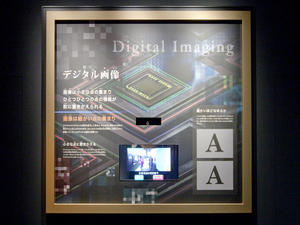Nagoya City Science Museum
TOP > Exhibition Guide > Keyword Search > Starting with "G" > Grey scale > Digital Imaging
Digital Imaging



Purpose of Exhibition
The image size and color depth determines the quality of an image taken with a digital camera. In this exhibition, you can learn about the quality of a digital image by changing an image size and color depth as you take digital images of your own.
Additional Knowledge
[Pixel Number]
A "pixel number" is one of the functions in a digital camera. This number shows how many censors in the world an image is taken with is divided into and digitized. For instance, suppose that taking an image with the ratio of 4:3 in length and width with a camera with 12 billion pixels, the image is presented with 4,000 dots in length and 3,000 dots in width. It always comes with a unit called a"pixel", and it is referred to as an image which is multiplied 3,000 pixels by 4,000 pixels.
[Linear Density]
Please make a copy of the image now. When you make 1 pixel 1millimeter square, a huge picture 4m in width and 3m in length will be appear. It looks nice from a distance, but when seen from up close, it is uneven. When making 1mm 10 pixels, it becomes 40cm in width and 30cm in length. It will look clear even on a table. In fact, it is indicated how many pixels it is per 1 inch. The unit is ppi (pixel per inch). 1 inch is 2.54cm.
[DPI and PPI]
There is a unit dpi (dot per inch) similar to ppi. A printer paints a piece of paper with ink. The minimal unit is dot. When making a copy of an image, it is not always that 1 pixel corresponds to 1 dot, and it is usual to make a copy with several dots for 1 pixel. Because of this, ppi and dpi differ, but it seems difficult to tell one from the other.
[Color Depth]
In digital images, a pixel has a specific color. The number of colors which can be applied in a digital image is called color depth.A personal computer made in around 1984 could only apply 16 colors, while a modern computer can deal with over 16 million colors.
[Grey scale]
A so-called black-and-white picture is actually made of colors from white through black. Image quality is also determined by how many levels the range between very black and very white can be indicated. This number of levels shows the color depth mentioned above and the bigger the number is, the clearer a black-white picture becomes.
[RGB]
In a computer, three primary colors of red, green, and blue light , are used to express colors. RGB is an acronym for red, green, and blue. When wanting to express colors, they are shown by how much of these three colors is contained. How many colors are included is also expressed in levels. The more levels it has, the more colors can be expressed. For example, If presenting colors with only two levels of colors, the numbers of colors which can be expressed is only eight (2x2x2) from each primary color. Many modern computers can express 256 levels of colors from each primary color. It means that a modern computer can deal with about 16.77 million colors (256 x 256 x 256).
Article by Tetsuo Ojio, curator
